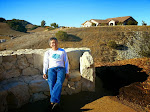The MAA plans to undertake a huge study of what's going on in college Calc I classes. They hope to survey 25% of Calc I classes across the US. Campuses not selected in the random sample will be given the opportunity to be take the survey to learn how they compare with the national sample, but their data will not be included in the national statistics. (From David Bressoud, speaking at the department liaisons meeting)
States have called for Common Core State Standards (CCSS) for K-12 math and English. The math group is being headed by Bill McCallum (U. Arizona). For the first time ever (to my knowledge), "modeling" will occur as a separate topic/strand in a math standards document. No working drafts have been made public, and public comment will evidently be limited to a few weeks in February 2010. Although the initiative came from states, the feds will support it by tying Race to the Top funds to compliance with CCSS. (AMS Committee on Education Panel Discussion, "The common core State Standards: Will they become our national K--12 math curriculum?")
Web 3.0 is the "Semantic Web"--searches will not be simply over key words but key concepts. The meaning of each item will be considered in the search. For example, your search can include the word "red" to refer only to the color and to ignore the name "Red" and the meaning of "communist". Or perhaps more enticingly, you can search for information about some algebraic expression (independent of Wolfram|Alpha). (From Tom Leathrum, speaking at the MathDL advisory board meeting)
The Committee on Technologies in Mathematics Education (CTiME) submitted a proposal to sponsor (jointly with the Web SIGMAA) a panel session about the tablet pc and similar mobile stylus-type devices for the 2010 MathFest in Pittsburg. This session will be dedicated in memory of Howard Penn, a long time CTiME member and supporter. The committee will attempt to hold an online meeting during the spring 2010. (Lang Moore, CTiME committee meeting)
Davide Cervone's newly unveiled MathJax looks like an exciting way to present math on the web. It's still undergoing final tweaking. (David Cervone speaking at a session of Publishing Math on the Web) Davide's design also will provide an improvement over programs like Beamer, which creates presentation slides with editable TeX-like math expressions. (Mike Gage chatting between sessions)
The Committee on Two-Year Colleges (CTYC) voted to co-sponsor (with CRAFTY) a College Algebra contributed paper session for JMM 2011. Rob Kimball talked about The Right Stuff, AMATYC's project about revamping college algebra. AMATYC president Rob Farinelli spoke about AMATYC's Project ACCCESS (a professional development program newly hired in tenure-track position community college math positions) and rapidly developing work on a grant proposal involving the Hewlett Foundation and the Dana Center: Mathway. (CTiME committee meeting)
CRAFTY's Curriculum Foundations II report (revamping college algebra) is in production. New committee chair Andy Bennett will investigate acquiring funds so that expenses could be paid to send CRAFTY/Curriculum Foundation II gurus to speak at MAA section meetings about best practices for a revised College Algebra. (CRAFTY committee meeting)
CRAFTY's next big project will be to investigate the course commonly called "Precalculus." The committee is providing the CBMS suggestions on possible questions for the next CBM survey. (CRAFTY committee meeting)
The MAA's new VMware and servers will allow the MAA to host websites for all the MAA SIGMAAs and sections. (John Wyatt, department liaison meeting)




